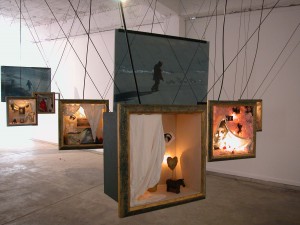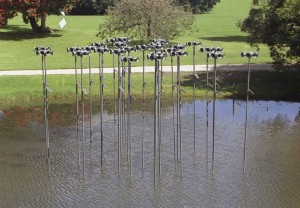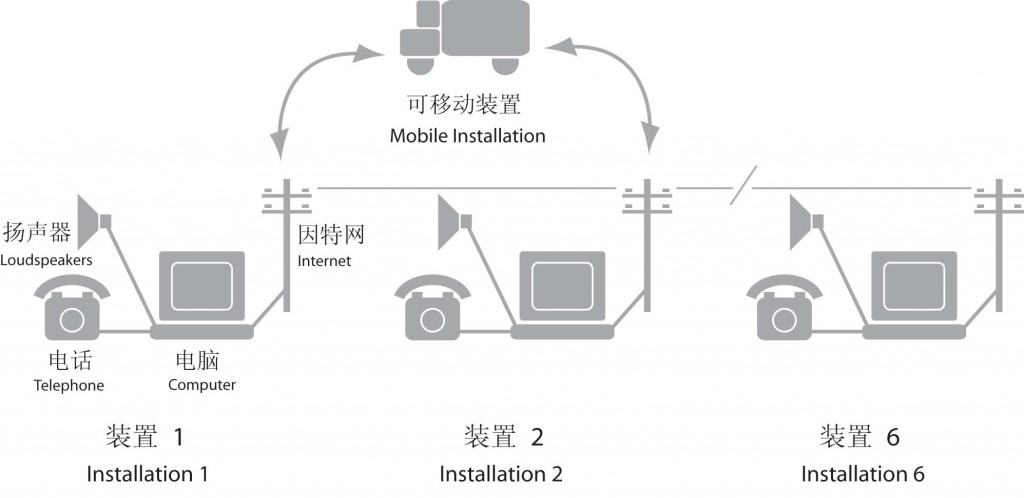Sound is a visceral substance inhabiting air, water and three dimensional space while driving the temporal domain. The concept of time-space is complex and open to stylistic and cultural variation. Sound art merges visual space, and time-space, in acoustic space. Sound and sound art have innate interdisciplinary characteristics of interest not only to the practitioners of the musical and fine arts including the plastic arts, but to architects, engineers, environmental designers and others. Sound’s chameleon like nature, its ability to bleed between boundaries and its ability to morph and change from one site to another, make it a challenging substance to handle and design.
In Australia today there is an exciting group of intrepid artists who are multi skilled taking up the gauntlet of designing sound through space and time. Over the past 10 years I have had the privilege of working full-time in the area as a practising sound installation artist, researcher and author. The following summary is based on the fruits of this 10 year research, a book and a website. The book Sound Sculpture: Intersections in Sound and Sculpture in Australian Artworks with audio CD collates, analyses and discusses the works of some 124 practitioners who have interfaced the three- dimensional field of sculpture with the fourth dimension, sounding time.

Gillian Chaplin and Les Gilbert Love is a Wonderful Thing Yarra Sculpture Gallery for the Hearing Place Exhibition of Sound Art, 2003
The Website, The Australian Sound Design Project, was set up to further explore how sound is being designed by artists in all of its forms but with a particular interest in the notion of public space. Over one hundred and thirty works have been published on the website alphabetically accessible through a Browse page.Works can be called up by artists, site, title, events, organisations and function. The inclusion of a multimedia gallery for each work allows not only for text, image, diagrams and audio, but also the temporal audiovisual video to be experienced. Aspects of sound art, artists and works can be searched, and refereed theoretical and multimedia papers read (Carter, Belfrage, Burt, Bandt, Paine). Other extensive research tools include a searchable bibliography, (340 entries) and links to software, funding and organisations.
The Artists
Many practitioners may or may not like to be labelled sound artists. The background of the artists is always interesting and varied. They have offered over 70 descriptors of their work and activities and most use a combination of over four terms to accurately assess their practice. Browse these descriptors for a reassessment of terminology. http://www.sounddesign.unimelb.edu.au/web/functionlist.htm . The largest number of entries appears under artists, sound artists, visual artists, sound designers, composers, improvisers, instrument makers, multimedia artists, systems developers and visual designers. Their works inhabit all kinds of contexts, embracing many hybrid outcomes, including digital music, radio, interactive sound installation, photography, web design, internet art, sound sculpture, film and video, screen, sculpture, performance art, events, dance, festival curators, computer music and noise. It is this hybridity that makes the world of sound art and design so exciting and unpredictable.
The Works
Sounding art works and sound designs come in many forms, from permanent to temporary or ephemeral, and indoor outdoor or virtual. For all sound works, decisions have to be made about:
- The type and composition of the sound it contains (pitch/time sonority/scale relationships).
- How the sound is installed into the acoustic space and context, its spatial dispersion, the durational programming of events, and whether there is any audience interactivity or not.
- The degree of change from one day to another has to be designed and this area has become much more complex over the past years with the possibility of complex system development softwares becoming readily available.
- The visual requirements of the environment can be as varied as complex sounding objects and sculptural and multimedia installations to invisible complex spatial music installations where the array of speakers through the space is the only perceivable physical component. These may or may not be invisible to the viewer.
- The role of the auditor and degree of interactivity.
Contexts and Examples: Sites and Solutions.
A large proportion of sounding art works are indoor works occurring in galleries for three-six weeks. Les Gilbert and Gillian Chaplin’s Love is a Wonderful Thing was commissioned for the Hearing Place Exhibition, 2003 at the Sculptors Gallery City of Yarra. A mixed media collaborative work it ’consisted of a matrix of sounding box-like assemblages, projection screens, video and photographs. Individual channels of sound were triggered on the listener’s approach to each box through the listening eye. The intimate sounds and assembled objects in each existing like a collection of private thoughts and memories.
This was one of two exhibitions and audiotheque of sound art and mixed media curated
by the Australian Sound Design Project to coincide with the international conference of the World Forum of Acoustic Ecology. The diversity of works exhibited can be seen and heard on http://www.sounddesign.unimelb.edu.au/site/news.htm. The audiotheque, at the VCA gallery brought together some 59 artists from 13 countries with sound works spanning classic electroacoustic and soundscape composition to pure unedited field recordings. Many of the works utilised ‘binaural’ recording techniques which when listened to with headphones, immerse the listener in a 3-Dimentional sound space. Over seven hours of audio were presented at a group listening station and at an individual station that allowed the listener to select each track. The Audiotheque was accompanied with projected texts on each work and biographies of each artist. Like many forms of sound art, the sound itself was the main focus with an audio CD Hearing Place being published by Move Records of the best 10 international works responding to place.
These works were available during gallery hours only, a factor which limits most gallery exhibition of sound art, when compared with outdoor or Internet art. The durational aspect of sound art may be intended to be short, as in the case of the radio broadcast, but it is interesting to see that most radio stations are documenting their programs on the Internet for greater temporal and geographic dissemination.

Nigel Helyer, MetaDiva, Werribee Park, 2002 Permanent outdoor sculpture and winner of the Helen Lempriere prize
Permanent outdoor sound art is one of the most difficult to execute. Nigel Helyer has a long track record in this field. His award winning work “Meta-Diva” is an environmentally sensitive sound sculpture, designed for installation at the Werribee Park wetlands site. It comprises thirty individual units, each with a solar powered digital audio ‘voice’ which emulates an element of the natural soundscape.
“Each unit contains a miniature digital audio chip, coupled to a digital timer, set individually so that each of the thirty units has a unique time signature. The audio chips contain short samples of natural history sounds, bird song, and insect song and frog voices. The combination of multiple sound sources, in conjunction with individual time signatures and the fluctuations ofthe solar power supply give the sound scape an un-cannily natural presence. Technically, this a type of emergent behaviour in which, although we might recognise the repetition of individual sounds, the overall soundscape is in fact an infinite mix; somewhat akin to the always familiar, but never repeating sounds of a creek. In reality, the soundscape blends so seamlessly with the natural environment it is quite difficult to distinguish the artificial from the natural soundscape. The physical structure of the sculpture employs the metaphor of plant biology and the thirty units are grouped as if to form a bed of Lotus plants.”
Over the past years sound art has embraced the design of complex sound systems and immersive environments. Notable in this respect are the works by Garth Paine, Map 1&2 and Gestation, which are extraordinary feats of contrapuntal sound shaped by the audience who can play with the system and make it their own, through whole body conducting. Gestation, shown at RMIT gallery in 2002 used David Rokeby’s Very Nervous System video synthesis as a controller of the elaborate sound fields which provided data from which emergent digital embryos were generated in the next room. The visual outcomes were generated in realtime from the interactive sound activity in the first room. Iain Mott’s interactive sound sculptures are often engaging and playful structures offering the auditor inventive interfaces to drive the sound such as the Talking Chair, the Squeezebox, and the Sound Mapping suitcases. Recent works include Close, incorporating video and binaural sound,and a future international project Chinese Whispers will use peer-to-peer networking to enable the sharing of spoken narratives between remote locations.

Iain Mott, Chinese Whispers, Future work in progress for China. Schematic diagram showing communication between installations.
The design of sound and dynamic systems in these works is elaborate. Paine and Mott’s works are elegantly designed from all points of view due to their multi- skilled backgrounds as composers, installation and visual artists, and their experience collaborating with other artists and with audiences. Both have developed original ways of integrating IT and coding skills for the service of their artistic visions.
There are many other exciting sounding art works documented on the website.
The Australian Sound Design Project is a rich Internet resource for sound art for all the community, free of charge. It offers an opportunity for artists to have a context to showcase their all-to-often ephemeral work. It is a place to watch and hear the emergence of an exciting new artform revealing itself at the moment of creation.
If you have original sound works you would like to include on the site visit or ring the office 83449951 and speak to Iain Mott or Ros Bandt.
Ros Bandt
The Australian Sound Design Project is situated at the Australian Centre at the University of Melbourne. It was funded by Dr Ros Bandt’s ARC grant, Designing Sound in Public Space 2000-2003 and the New Media Arts Board of the Australia Council. Hearing Place was funded by the City of Yarra and Move Records, the Sculptors Association, the VCA and the Australian Centre. The author would like to thank Iain Mott and Garth Paine for their assistance in the project’s web design and authoring over the three years.
Read More
http://www.sounddesign.unimelb.edu.au
Find out more about Ros Bandt’s work at:
http://www.sounddesign.unimelb.edu.au/web/biogs/P000012b.htm
 This work is licensed under a Creative Commons Attribution-NonCommercial-ShareAlike 3.0 Unported.
This work is licensed under a Creative Commons Attribution-NonCommercial-ShareAlike 3.0 Unported.






